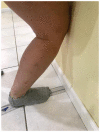Evaluating the Clinical Tests for Adolescent Tibial Bone Stress Injuries
- PMID: 33576312
- PMCID: PMC8404772
- DOI: 10.1177/1941738120988691
Evaluating the Clinical Tests for Adolescent Tibial Bone Stress Injuries
Abstract
Background: Tibial bone stress injuries are common among the athletic adolescent population. A thorough patient history and clinical examination are essential to identify the location and extent of injury. However, there has been little description or any validation of clinical tests to help guide clinicians. Consequently, a formal diagnosis is usually dependent on results from proper imaging.
Hypothesis: Clinical examinations will be both highly sensitive and specific determining the incidence, grade, and location of tibial bone stress injury as compared with magnetic resonance imaging (MRI).
Study design: Case-control.
Level of evidence: Level 2.
Methods: A total of 80 consecutive athletic adolescents, from various sports, with greater than 1-week history of shin pain were enrolled in this institutional review board-approved study. Exclusion criteria were age >19 years and history of traumatic injury. Patients underwent a standardized clinical examination, which included a fulcrum test (FT), tap/percussion test (TT), vibration test (VT) utilizing a 128-Hz tuning fork, weight bearing lunge test (WBLT) to determine degree of dorsiflexion range of motion (ROM), and vertical single leg hop test (VSLHT) for height, landing, and pain. Bilateral lower extremity MRI was completed on the same day as clinical evaluation and served as the injury reference. Sensitivity, specificity, positive predictive value (PPV) and negative predictive value (NPV) were calculated to evaluate each clinical examination for its ability to identify a bone stress injury.
Results: A total of 159 tibiae in 80 patients were evaluated. No single test or combination of tests was both highly sensitive and specific. Individual clinical tests demonstrated sensitivity ranging from 0.11 to 0.72 and specificity ranging from 0.37 to 0.93. The VSLHT noting an increase in pain was the most sensitive test (0.72; 95% CI, 0.62-0.78); however, its specificity was only 0.37 (95% CI, 0.19-0.55), with a PPV of 0.84 (95% CI, 0.78-0.91) and NPV of 0.20 (95% CI, 0.089-0.31). The WBLT demonstrated a mean ROM of 8 cm, with side-to-side differences (range 0-4 cm) not influencing incidence of injury. Combinations of tests demonstrated low sensitivity (0.03-0.40), with better specificity (0.63-1.0). When considering ability to identify higher grades of injury (grade III/IV), all tests had a high NPV indicating that if clinical tests were negative, there was a high likelihood that the patient did not have a grade III or IV injury.
Conclusion: No single test or combination of tests was both highly sensitive and specific. Clinicians cannot solely rely on clinical examination for determining extent or severity of bone stress injury in the athletic adolescent population, but when combinations of tests are negative, there is likely not a high-grade bone stress injury.
Clinical relevance: Clinical tests utilized in the evaluation of adolescent tibial bone stress injury may help indicate the presence or absence of higher grade tibial bone stress injury.
Keywords: adolescents; bone stress injury; clinical examination; tibia.
Conflict of interest statement
The authors report no potential conflicts of interest in the development and publication of this article.
Figures
Similar articles
-
Retrospective Review of Radiographic Imaging of Tibial Bony Stress Injuries in Adolescent Athletes With Positive MRI Findings: A Comparative Study.Sports Health. 2023 Mar-Apr;15(2):244-249. doi: 10.1177/19417381221109537. Epub 2022 Aug 2. Sports Health. 2023. PMID: 35918903 Free PMC article.
-
CT and MR imaging findings in athletes with early tibial stress injuries: comparison with bone scintigraphy findings and emphasis on cortical abnormalities.Radiology. 2005 May;235(2):553-61. doi: 10.1148/radiol.2352040406. Radiology. 2005. PMID: 15858094
-
Accuracy of the Tuning Fork Test for Determination of Presence and Location of Tibial Stress Fractures in a Military Training Population.Mil Med. 2021 Jul 1;186(7-8):733-736. doi: 10.1093/milmed/usab052. Mil Med. 2021. PMID: 33576428
-
Stress fractures of the tibia and medial malleolus.Foot Ankle Clin. 2013 Jun;18(2):339-55. doi: 10.1016/j.fcl.2013.02.010. Foot Ankle Clin. 2013. PMID: 23707181 Review.
-
Stress fractures in athletes.Top Magn Reson Imaging. 2006 Oct;17(5):309-25. doi: 10.1097/RMR.0b013e3180421c8c. Top Magn Reson Imaging. 2006. PMID: 17414993 Review.
Cited by
-
Prospective Assessment of Clinical Tests Used to Evaluate Tibial Stress Fracture.Orthop J Sports Med. 2022 Sep 16;10(9):23259671221122356. doi: 10.1177/23259671221122356. eCollection 2022 Sep. Orthop J Sports Med. 2022. PMID: 36147792 Free PMC article.
-
Physical Therapy Perspectives for Medial Tibial Stress Syndrome in a Novice Runner: A Case Report.Cureus. 2024 Aug 23;16(8):e67647. doi: 10.7759/cureus.67647. eCollection 2024 Aug. Cureus. 2024. PMID: 39314590 Free PMC article.
-
The Running Readiness Scale and Injury in Collegiate Track and Field and Cross Country Athletes.J Athl Train. 2025 Apr 1;60(4):301-307. doi: 10.4085/1062-6050-0309.24. J Athl Train. 2025. PMID: 39838857
-
Criteria and Guidelines for Returning to Running Following a Tibial Bone Stress Injury: A Scoping Review.Sports Med. 2024 Sep;54(9):2247-2265. doi: 10.1007/s40279-024-02051-y. Epub 2024 Aug 14. Sports Med. 2024. PMID: 39141251 Free PMC article.
-
Case report: A rare Salter-Harris V metaphyseal fatigue fracture of the knee in an adolescent patient with obesity.Front Pediatr. 2023 Jun 22;11:1209369. doi: 10.3389/fped.2023.1209369. eCollection 2023. Front Pediatr. 2023. PMID: 37425269 Free PMC article.
References
-
- Batt ME, Ugalde V, Anderson MW, Shelton DK.A prospective controlled study of diagnostic imaging for acute shin splints. Med Sci Sports Exerc. 1998;30:1564-1571. - PubMed
-
- Beck B.Can therapeutic ultrasound accurately detect bone stress injuries in athletes? Clin J Sport Med. 2013;23:241-242. - PubMed
-
- Bennell K, Matheson G, Meeuwisse W, Brukner P.Risk factors for stress fractures. Sports Med. 1999;28:91-122. - PubMed
-
- Bennell K, Talbot R, Wajswelner H, Techovanich W, Kelly D, Hall A.Intra-rater and inter-rater reliability of a weight-bearing lunge measure of ankle dorsiflexion. Aust J Physiother. 1998;44:175-180. - PubMed
-
- Brukner P, Bennell K.Stress fractures in female athletes. Diagnosis, management and rehabilitation. Sports Med. 1997;24:419-429. - PubMed
MeSH terms
LinkOut - more resources
Full Text Sources
Other Literature Sources
Research Materials
Miscellaneous


